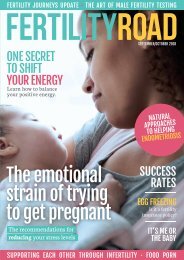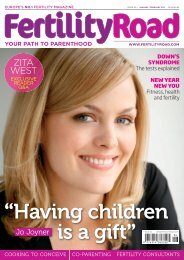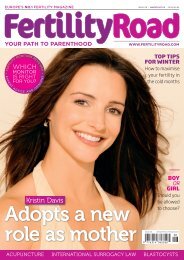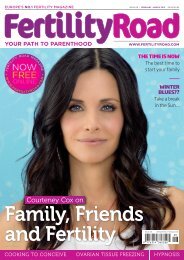Fertility Road Issue 06
You also want an ePaper? Increase the reach of your titles
YUMPU automatically turns print PDFs into web optimized ePapers that Google loves.
FEATURE | |mini-IVF<br />
CASE<br />
STUDIES<br />
In reality mini- IVF is tricky<br />
and many centres are unable to<br />
perform it successfully as there is<br />
absolutely no margin for error.<br />
the air quality in the operating theatre. Organic, volatile toxins are<br />
present in microscopic quantities in the air – while these do not<br />
affect our wellbeing on a day-to-day basis, they do have an adverse<br />
effect on embryos, causing damage through over exposure. “We<br />
cannot stress how important this is to mini-IVF,” adds Silber.<br />
The very unusual approach to minimal stimulation also plays a<br />
very large part in the success of this procedure, with smaller<br />
numbers of better quality eggs retrievable through gentler<br />
hormone administration – i.e. shaking the tree rather than<br />
chopping it down. While less eggs will be retrieved, they have a<br />
better prognosis for success.<br />
The storing procedure for the embryos plays the final part in<br />
the success of mini-IVF, with vitrification paramount. Vitrification<br />
is a new freezing technique that uses super high concentrations<br />
of anti-freeze (DMSO and ethylene glycol) to allow a drop in<br />
temperature so rapid the water never actually becomes ice. If ice<br />
gets into the cells during the freezing procedure, it will damage<br />
the cell during the defrosting process. With vitrification, embryos<br />
can be frozen and defrosted several times without any risk.<br />
The procedure<br />
So how do patients interested in mini-IVF go about this procedure<br />
and how does it differ from traditional IVF in its administration?<br />
With this more gentle approach, day three of the menstrual cycle<br />
is when mini-IVF patients are given low doses of Clomid (50mg).<br />
They continue to take this drug until an ultrasound shows there are<br />
sufficient follicles ready for ovulation. Staying on Clomid for longer<br />
than the usual five days associated with traditional IVF stimulates<br />
natural pituitary and releases FSH by blocking the suppressing the<br />
effect of estrogen. A very low boost of Gonadotropin is then added<br />
on days eight, 10 and 12 of the cycle.<br />
Other than the cost advantages – Clomid is cheaper than those<br />
stronger hormones that need to be injected – another advantage<br />
“We recently took care of such<br />
a case in a young woman I had<br />
known since she was a little girl,”<br />
says Dr Silber about one of his<br />
first mini-IVF patients. “She had<br />
undergone multiple surgeries at various clinics for other health<br />
problems, but the result of her cure was just one remaining ovary<br />
with hardly any eggs left. In fact she did not just want one baby<br />
but a big family. The misery this brave young woman had to go<br />
through was heartbreaking, being told by everyone that she<br />
would never be able to have her own children. We put her through<br />
a total of six cycles of mini-IVF, retrieving only a few eggs each<br />
time until she eventually had 10 healthy embryos in storage. This<br />
resulted in a healthy pregnancy and enough frozen embryos to<br />
eventually have the big family she had always dreamed of.<br />
Another example is a 43 year-old woman who married at 38 to<br />
a 34 year-old man. She had already conceived naturally before but<br />
wanted a second child and was told donor eggs were her only<br />
option. Not wishing to have her son’s sibling with a different DNA<br />
to his own, she visited St Luke’s Hospital in St Louis and went<br />
through two rounds of back-to-back mini-IVF cycles, storing up to<br />
three embryos, only one of which looked viable. Six months later,<br />
the embryo was thawed and transferred back into her uterus for<br />
implantation. The patient gave birth to a healthy baby at 44<br />
without the need for donor eggs.<br />
A more determined case was in that of a 45 year-old woman<br />
who underwent four cycles of mini-IVF stimulation resulting in a<br />
healthy 14 frozen embryos. However, as was to be expected due<br />
to the age of the embryos, and despite transferring four during<br />
the first attempt, the patient failed to get pregnant. However, six<br />
months later we thawed and transferred four more embryos,<br />
finally delivering a healthy baby using her own eggs at the age<br />
of 46. This lady has six frozen embryos remaining meaning<br />
it’s possible for her to have a second child in a few year’s time<br />
before she reaches the maximum age for treatment of 50. How<br />
wonderful would it be for her to be able to give birth to a sibling<br />
for her first miracle birth?<br />
is that patients do not need to take Lupron at the beginning of the<br />
cycle, rather at the time of ovulation through small injection or<br />
nasal sniff. This causes a more natural LH surge and avoids the<br />
defects that can be caused by a HCG injection – the ovulation<br />
booster used in more traditional IVF.<br />
Patients then embark on several of these treatment cycles backto-back,<br />
waiting until there are sufficient embryos formed before<br />
attempting to have them implanted back.<br />
Unfortunately at the present time, mini-IVF is only available in<br />
the United States, but hopefully Dr Silber’s work will eventually<br />
become more readily available in Europe for older woman with<br />
fewer egg reserves.<br />
24 fertility road | may - june
















